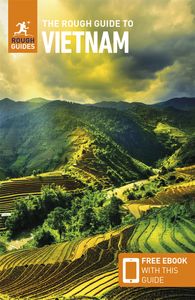Quan Thanh Temple
Although the summer palace no longer exists, the eleventh-century Quan Thanh Temple still stands on the lake’s southeast bank, erected by King Ly Thai To and dedicated to the Guardian of the North, Tran Vo, who protects the city from malevolent spirits. Tran Quoc Pagoda, Hanoi’s oldest religious foundation, occupies a tiny spur of land off Thanh Nien, which separates West Lake from Truc Bach. About a kilometre north of the causeway, the red-tiled roofs of Kim Lien Pagoda provide an incongruous neighbour for the Intercontinental Hotel.
Tran Vo statue
It’s well worth wandering into the shady courtyard to see the 334-year-old black bronze statue of Tran Vo, seated on the main altar. The statue, nearly 4m high and weighing four tonnes, portrays the Taoist god accompanied by his two animal emblems, a serpent and a turtle. It was the creation of a craftsman called Trum Trong, whose own statue, fashioned in stone and sporting a grey headscarf, sits off to one side.
The shrine room
The shrine room also boasts a valuable collection of seventeenth- and eighteenth-century poems and parallel sentences (boards inscribed with wise maxims and hung in pairs on adjacent columns), most with intricate, mother-of-pearl inlay work.
Museum of Ethnology
Out in the suburbs of Hanoi on Nguyen Van Huyen, a couple of kilometres west of West Lake, the Museum of Ethnology is a bit of a way out, and best visited with a rented vehicle, although it more than repays the effort, particularly if you’ll be visiting any of the minority areas. Spread across two floors, the displays are well presented and there’s a fair amount of information in English on all the major ethnic groups. Musical instruments, games, traditional dress and other domestic items that fill the displays are brought to life through musical recordings, photos and plenty of life-size models, as well as captivating videos of festivals and shamanistic rites. This wealth of creativity amply illustrates some of the difficulties ethnologists are up against – the museum also acts as a research institute charged with producing ethnologies for Vietnam’s 54 main groups plus their confusion of sub-groups. The grounds contain a collection of minority houses relocated from all over Vietnam, dominated by a beautiful example of a Bahnar communal house.






















